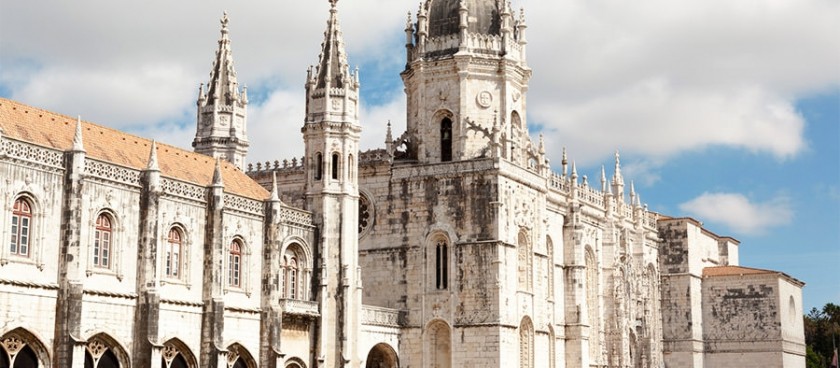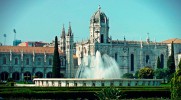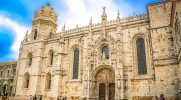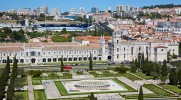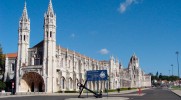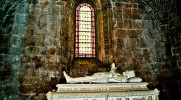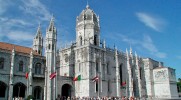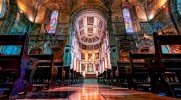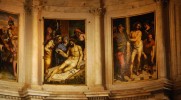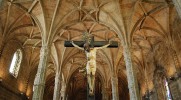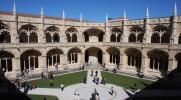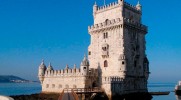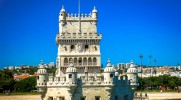- #PT16
- Praça do Império 1400-206 Lisboa, Portugal
- +351213620034
- geral@mjeronimos.dgpc.pt
- http://www.mosteirojeronimos.pt/
- Working hours*:
October to april - From 10 a.m. to 5:00 p.m.
May to September - From 10 a.m. to 6:30 p.m.
Outubro a abril, das 10h00 às 17h00. Maio a setembro, das 10h00 às 18h00. Sundays e Religious hollidays - October to april, das 2 p.m - 7 p.m - * - opening and closing times as well as entrance prices, are subject to alterations without notice. Visitors are advised to check before visiting.
- 38.6978909, -9.2067039 Copy to clipboard Copy
-
#Monasteries
Openwork, as if woven from lace, the Portuguese monastery of Jeronimos is one of the UNESCO World Heritage Sites. It is impressive for its architecture - you will not find anything like it in Lisbon anymore. The Manueline style in which this complex was built was created especially for him. And another feature of the monastery is that several great Portuguese are buried here, including the traveller Vasco da Gama, the writer Luis de Camões, the poet Fernando Pessoa and others.
Construction history
The idea of founding the Jeronimos monastery at the mouth of the Tagus River belongs to King Manuel I. However, it took about 100 years from the first stone laid in the foundation to the end of construction. The entire history of this monastery complex is associated with navigation.
It began with a small chapel located in this place in the middle of the 15th century. The Chapel of Santa Maria de Belem founded by Prince Heinrich the Navigator. Which famous as the organizer of several famous sea expeditions. In this chapel, the famous Vasco da Gama prayed for the success of his venture. Sending the explorer on a voyage, King Manuel I made a vow that if the expedition were successful, he would build a large monastery here so that the monks could pray for the sailors.
And so it happened - in 1502, it laid the foundation of the future complex. For the next 20 years, construction went briskly and successfully. Thanks to the sea route laid by Vasco da Gama, Portugal was actively engaged in trade, which provided generous funding. However, from 1520 to 1550, the work was suspended and then resumed under the leadership of another architect. He engaged four architects in the Jeronimos Monastery: Diego de Boytac, Diego de Toralva, Juan di Castillo and Nicolas Chantarin.
Surprisingly, the fragile-looking building of the monastery withstood even the earthquake of 1755, which almost destroyed Lisbon. At the beginning of the 19th century, it made specific changes to its appearance - built two turrets, the bell tower damaged by an earthquake renewed. However, in 1834, when banned reforms in Portugal and religious orders, the Jeronimos monastery ceased. Since the building has belonged to the state, today, in addition to the church, a museum has opened.
Today's view
In the wake of sea voyages and great geographical discoveries in Portugal, a new architectural style appeared, called Manuelino - a mixture of Gothic and Renaissance with elements of Moorish decor. And the first building that built in this style was the Jeronimos Monastery. Today it amazes tourists with its rich, quirky decoration, in which branches of overseas plants, twisted ropes, shells with pearls, lianas and flowers intertwined.
The facade, decorated in this way, stretches for 300 meters, ending on the left side with the Maritime Museum. A large anchor installed in front of it, which serves as a reference point for visitors. On the western side is the Archaeological Museum.
Also, tourists should linger at the southern portal of the building - it is not the entrance to the Jeronimos monastery, but it is interesting for its design. The portal decorated with statues of Henry the Navigator, the Virgin Mary and saints revered in Portugal.
The main entrance to the building is through an archway to the left of the southern portal. It is also a real work of art, created by the hands of Nicolas Chantarin. Above the doorway, the sculptor depicted scenes from the life of Jesus Christ, and on the sides, he decorated the entrance with statues of King Manuel I and Queen Mary with Saints Jerome and John the Baptist.
Excursions
The Jeronimos Monastery conducts thematic excursions for schoolchildren and students. Also, can order an excursion tour for eight people, but it recommended to contact the administration in advance and notify them about the visit. The rest of the visitors can buy a ticket and see all the sights on their own. Even an independent walk through this complex will help you learn many interesting things about Portugal's history and cultural heritage.
Right at the entrance, visitors can see two famous tombstones - one of them belongs to Vasco da Gama, and under the other lies the "Portuguese Pushkin" Luis de Camões. Kings Manuel I and João III and their wives buried in the altar chapel under slabs with marble elephants. And in the chamber of the chapters is the tomb of Alexandre Erculano, a famous Portuguese writer of the 19th century. By the way, he was also the first head of Belem.
Walking through the halls of the church, you can move to the covered gallery, which the monks used to be used for meditation, reading and walking. Thanks to the intricate openwork stucco moulding, it is considered one of the most beautiful in Portugal and throughout the world. Here you will see a modest marble slab, under which the poet Fernando Pessoa, who was very fond of the Jeronimos monastery, found peace.
Another interesting place is the monastery refectory. This huge room, decorated with biblical scenes, has excellent acoustics. During the meal, one of the monks read the Bible to the others, and his voice echoed under the arches, reaching all corners. The end tour of the Jeronimos Monastery is on the second floor, where a beautiful view of the church opens from the height of the choirs.
How to get there
Option 1: Bus: routes 15E, 729, 201, 714, 727, 728, 751 to the Mosteiro dos Jerónimos stop.
Option 2 Metro: take the green line to Cais do Sodré. Bus: change to bus 15E or 728 and get off at Mosteiro stop dos Jerónimos.
